Don't wanna be here? Send us removal request.
Text
DESN2002 Assessment 3
The United nations sustainable development goals have been a major focus for our group this semester. With particular reference to goal 12; ‘ Ensure sustainable consumption and production patterns’. We decided early on that we would address this goal by creating awareness and a solution to the fast fashion waste industry.
My group consisted of seven members; being myself, Arlee Verschoor, Joel Holdsworth, Krystal Webb, Shaylee Dean & Hannah Rallings.
With progressive steps towards a free online service app we landed on the title ‘Altered’ as this would insinuate a different and sustainable approach to buying and recycling clothes. We followed the design thinking process to empathize, define, ideate, prototype and test our service. This brought many great ideas and resulted into a planned app in which we were all extremely proud of.
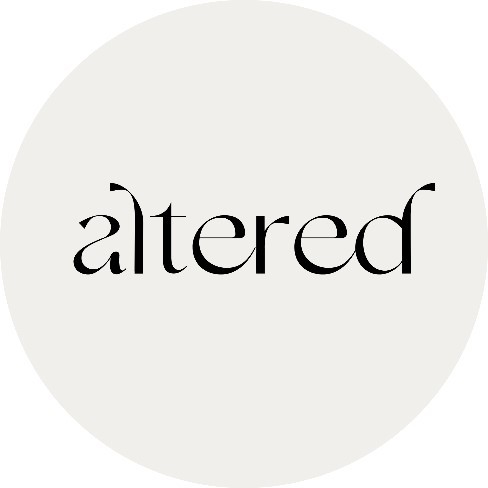
One key aspect of our service was the process itself. We based our intentions off of a model outlined by David Kelly in an interview with Avi Solomon; “…doing things with intention, trying to decide what's important to somebody, building a bunch of prototypes and showing them around, developing a point of view and getting it out so that it has impact in the world.” (Solomon, 2012). We felt that the problem of the fast fashion waste industry was significant to everybody around the world, however we narrowed our target demographic to 18-25 year old students as they are far more likely to partake in such fast fashion buying. Thus considering the current climate of social media and its respective popularity among our target demographic, we decided that an easy-to-use social media application would appeal most to these students and hence allow for an effective result.
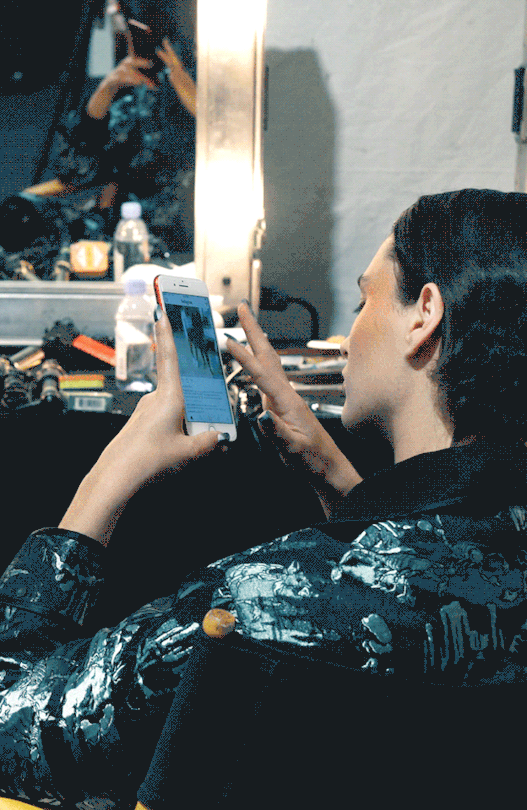
Personally I was responsible for various roles within the group. These include constructing our user journey map, persona card and empathy maps. The empathy map and persona card are tied together in that we based a 24 year old student persona on their experience with buying a new a item of clothing.
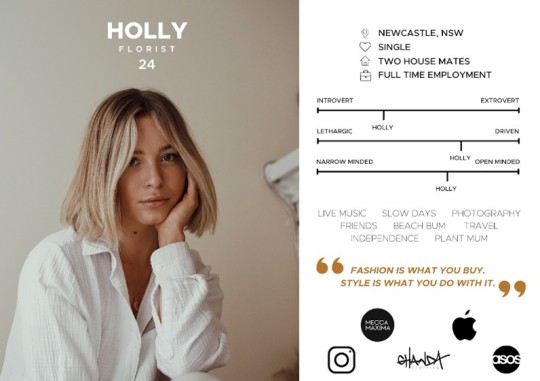
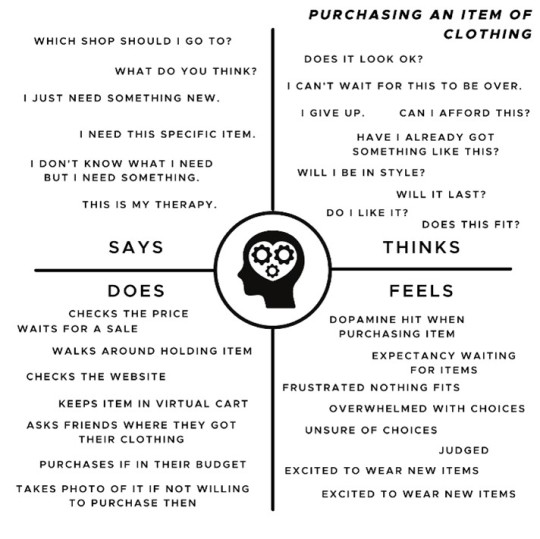
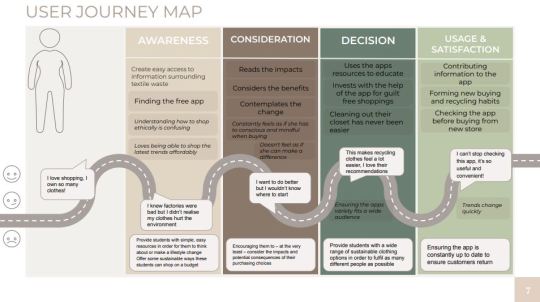
Our main approach to solving such a wicked problem was to firstly educate people and students of the issue, hence we wanted to make the app accessible, offering a free app. The next step is to then encourage consideration of the potential consequences and environmental impacts that the fast fashion industry leaves behind, in which students and users of the app will then also consider the benefits of recycling. This will then ultimately lead to a more educated decisive action about what to do with their unwanted clothes. And finally we wanted to ensure that the apps’ benefits will then become integral to be apart of their shopping desires and thus create a more sustainable clothing industry.
“If you are creating a complicated interactive system, the experience of learning how to understand and interact with the system is an important part of the overall design problem.” (Zimmerman & Pozzi, 2016).
With inspiration from the above quote we explored many different avenues of how to engage our target audience and believe that a user-friendly app was the best route to take.

(Wahl, 2017) - Image
We unpacked what was necessary to achieve longevity within the fast fashion industry. “Our societies are unsustainable because mass production has allowed designer empathy to go unchecked.” (Tonkimwise, 2016). This really struck home within me and hence made me consider the problem from many different perspectives.
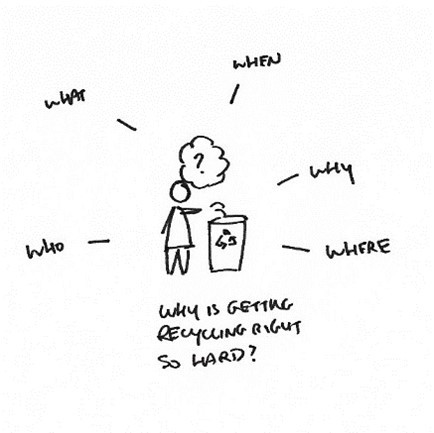
(Ming, 2016) - Image
Another focus of our design thinking procedure and innovation was to reach out and talk to other people about how they feel about the fast fashion dilemma. We interviewed Kristelle asking her about if she is informed about the environmental impact of fast fashion.
youtube
Furthermore, we also created a walkthrough video of what the app would like including many of its key features and focus areas.
“The gift of Design Thinking for education is the ability to incorporate the hands-on engagement of making something within the broader lessons that expand to all areas of curricula.” (Thomas, 2016).
youtube
Overall it was an absolute pleasure to be apart of the ‘Altered’ team and working on this project has been truly motivating and inspiring. I am grateful for everyone involved and wish to continue such prospects in the future.
“Sometimes innovation has to account for vast differences in cultural and socioeconomic conditions. In such cases design thinking can suggest creative alternatives to the assumptions made in developed societies.” (Brown, 2008)
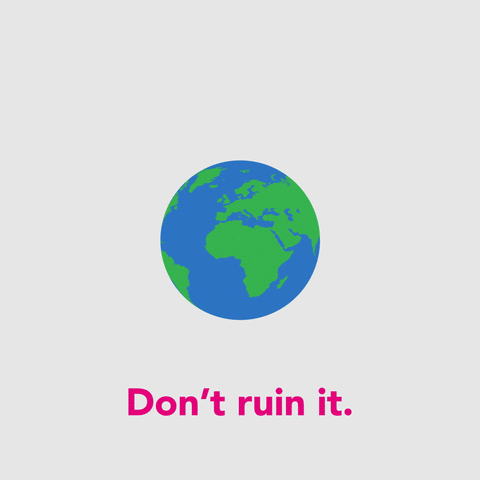
Our final presentation - DESN2002-FinalPresentationP.pdf
REFERENCES
Brown, T 2008, ‘Design thinking’, Harvard Business Review, vol. 86, no.6, pp. 84–92
Ming. (2016). Understanding Where Recycling Goes Wrong: A Wicked Problem. Medium. Retrieved 10 June 2022, from https://medium.com/transition-design/understanding-where-recycling-goes-wrong-a-wicked-problem-d8d4ad1dd6f5.
Solomon, A & Kelly, D 2012, September 22, ‘Design Thinking for Social Good: An Interview with David Kelley’, , Boing Boing, viewed 10 June 2022, https://boingboing.net/2012/09/22/design-thinking-for-social-goo.html
Thomas, P 2016, April 10, ‘“What’s the difference between Design Thinking and making?”’, , Medium, viewed 10 June 2022, https://medium.com/@parkerthomas/what-s-the-difference-between-design-thinking-and-making-614cb089bc5e
Tonkimwise, C 2016, March 16, ‘Contempt by Design: When Empathy turn into Hatred of Everyday Life’, , The Overlap, viewed 10 June 2022, https://medium.com/the-overlap/contempt-by-design-b3facdc8be47
Wahl, DC 2017, April 29, ‘Facing Complexity: Wicked Design Problems’, , Age of Awareness, viewed 10 June 2022, https://medium.com/age-of-awareness/facing-complexity-wicked-design-problems-ee8c71618966
Zimmerman, E & Pozzi, N 2016, June 30, ‘Donʼt follow these rules! A Primer for Playtesting’, , Eric Zimmerman, viewed 10 June 2022, https://static1.squarespace.com/static/579b8aa26b8f5b8f49605c96/t/5962a494bebafbc89ca001b6/1499636884792/A+Primer+for+Playtesting.pdf
0 notes
Text
Editing
This week our group was in the editing stages of our short film. We have decided to splice the shots together on Adobe Premier Pro. Due to the comedic nature of our film we have had a lot of fun with the editing stage of this project. Whilst we faced many challenges trying to open the software and trouble with the internet, we overcame these obstacles by persevering and trying new computers. Eventually we were able to open the program and hence start glorifying our film. Although Grace is technically the ‘Editor’ we were all more than happy to help out with the edit. My individual role in this exciting process of editing was to overlook the art creativity of the scenes. Since the main character in the film was also me i didn’t hesitate to experiment with different colour grades and trippy editing techniques.

Another obstacle our group faced was the fact that not everyone in the team was present, and hence the obvious challenges that came with this were that we couldn’t get everyones input. However, as we had no other option we continued to soldier on and continue editing. Another aspect of our creative collaboration that was especially hard to swallow in this editing stage was the fact that due to this conflict of non-attendance, we were unable to for-fill our desire to film more ‘set-up’ shots. That is, we made the executive decision to spend more time editing rather than filming since we would not have had time, and time is always of the essence. I look forward to showcasing this film and handing it in this Sunday night. It has been a great experience working on this project and couldn’t have done it without the help of my team, I have gained some great insight into film editing which i will be forever grateful for.

0 notes
Text
Trip to Nowhere
Our group’s short-film making project has now entered the editing stages, although a few final filming shots must first be completed. Our psychedelic inspired short comedy was filmed in and around the city of Newcastle, Australia on Tuesday 18th May 2021. Over much speculation, I agreed to be the main character in which I started to have hallucinations after drinking a ‘special’ pink lemonade drink. Another group member Lachlan agreed to be the character manning the ‘Lemonade stall’ and hence giving me the drink. After a series of events at Civic Park, Newcastle light rail and Nobby’s Beach Headland we managed to capture some fun and exciting scenes.
Some of the films that have inspired us are:
‘The Big Lez Show - Choomah Island’ https://www.youtube.com/watch?v=BiFJDQkmXMA
‘The Big Labowski’ - Magic Carpet Scene

My role as the main character in the collaborative short film making group project was not only to act in the main scenes, but to give some creative input into the art directing as well. Grace and I were given the task of supplying the props for the film. These included; pink lemonade bottle, yellow lemonade bottle and the ‘Lemonade’ sign. All of these props were not challenging to find and hence made the filming more efficient. I was also given the task of driving some of the team members to the different locations set to film. I found this task to be quite fun. Some obstacles we faced were the fact that not all of our team members were present for the filming, and hence we could not get all the filming done in the one day as planned. To overcome this obstacle we have decided to add an extra day filming to add some final touches and meet the criteria of ‘all members’ in the film at least once.
0 notes
Text
Art Directing
Recently I have been appointed as the Art Director for a project involving a short 1-2 minute film. Broadly, this job involves managing a team of designers working on a creative project, but the degree of responsibility and autonomy can vary.
"As an art director you must be a leader; someone who inspires and guides the vision of the design team," explains Blimp Creative founder James Fenton. "You have to be able to recognise the talent in those around you and learn how best to get the best from them."
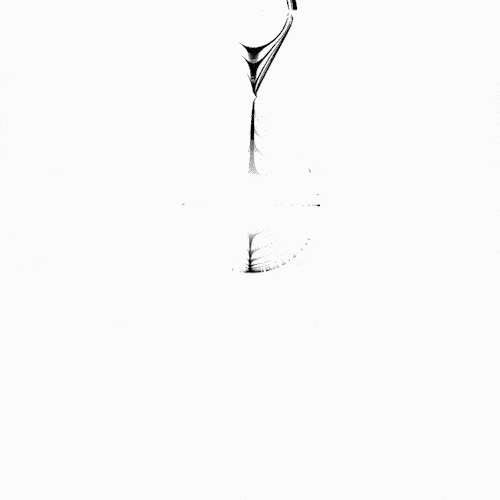
This has been a fun and exciting role to be apart of. I have been experimenting with different colours of drinkable water to portray the pink lemonade.
Art director Jenny Theolin comments: "For me, the main difference between working as a graphic designer and as an art director was that I worked more with people than computers. And since I prefer to see the creative industry as a peoples' industry, this collaboration and co-working was key to creating exciting new work."
We have also been discussing different editing and filming techniques. Some of which include Slapstick style films. As we decided the genre of our film is comedy, and to further represent the random luminosity of the hallucination we thought that slapstick would fit this bill.
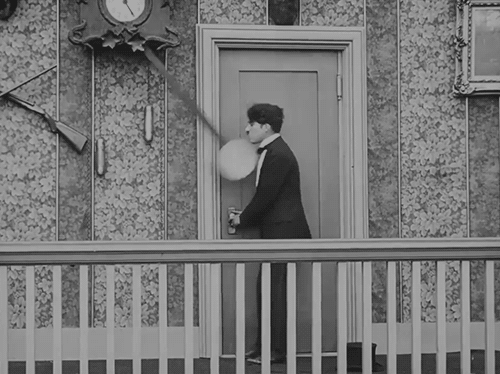
Slapstick, a type of physical comedy characterised by broad humour, absurd situations, and vigorous, usually violent action. The slapstick comic, more than a mere funnyman or buffoon, must often be an acrobat, a stunt performer, and something of a magician—a master of uninhibited action and perfect timing.
A good example of such style can be shown within a lot of Charlie Chapman films. I look forward to the challenges and hurdles that this project will offer me in my role as art director. Below is a fine example of one of the scenes from a Charlie chapman film.
Charlie Chaplin - The Kid - Fight Scene:
https://www.youtube.com/watch?v=Z7-QdoofMq8
0 notes
Text
Pink Lemonade
The short film extravaganza has been fleshed out into a more sophisticated series of events. The story line includes but is not limited to the following ideas..
Hallucinogenic Drink

The main character who is yet to be confirmed from our team, has accidentally drank a hallucinogenic drink of pink lemonade and starts to trip. As the camera zooms into the dilated eye, there are both internal and external random experiences that he/she encounters.
The Newcastle Light Rail Tram
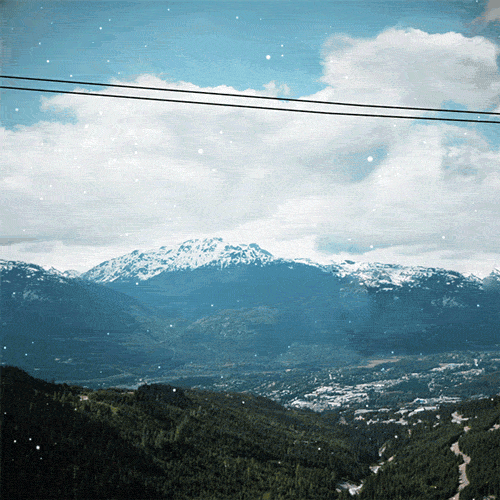
The Newcastle Light Rail will play an important role in connecting the story together. With the film set for the main character to start walking towards the light rail tram, soon after jumping aboard the carriage the hallucinations start to unfold. As the film will portray that the character participating in real-world activities (outlined below), this will in fact all just be an an illusion as the film will end with a humorous twist; the light rail doors opening with the main character on the ground, revealing that he/she did not actually leave the carriage at all. It was all in his/her mind.
Random Scenes and Characters
- We have appointed a speaking dog to be telepathically communicating with the main character, to take place at Nobbys headland
- The town hall bell chiming throughout the trip to signify hours have passed
- Every team member will be in most shots in the background, creating a mysterious easter egg / ‘Where's Wally’ type cameo
- The use of musical instruments within the hallucination
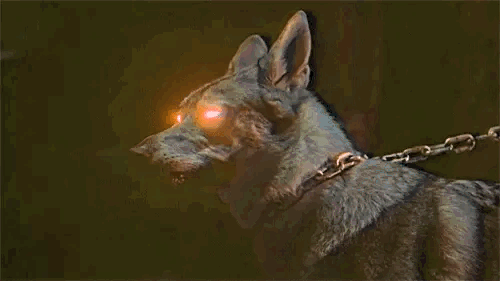
Evaluation:
We have all decided to share around the specific roles of working in the team, as neither of us are particularly great in one area or another. I have personally volunteered to organise a run sheet for filming. Although this was challenging at first, it has turned out to be an efficient way of structuring the filming. I believe with the ideas and roles in play it will be a fun and collaborative project and can’t wait to see the final product.
0 notes
Text
Short Film Extravaganza
The irony of what is to become a comedy classic, is that such story has not yet been created. I have complete faith that the three team members who I have not-yet met will help create a humorous film. However if all else fail, and true to its definition, it will either way be a comedy gold. Between the two of us, we bounced some ideas off each other regarding storyline however without the input of the Writer / Director, Sound Designer and Producer the full storyline was not disclosed.
Open to interpretation, the story is about a lonely boy who is wandering the streets of Newcastle, he is on his way to a pink lemonade stall in which he has heard to be extremely popular. On the way there he keeps seeing a large pink pineapple in spots for it only to disappear when he looks again. When he finally reaches his destination he is feeling very confused. There are hundreds of people there, all with the same staring eyes; big dark bulging pupils. As he approaches the front of the line he realises that they are serving pink pineapple lemonade, and he starts to wonder; “what if the pineapples I saw on the way were actually real, what does this mean?”
This character, who is currently nameless must find a way to answer these questions. He takes a sip and suddenly his whole world turns pink. Stunned by this new reality he walks toward a parked car on the street beside him. As he peers down into the reflective tinted window the face that is looking back at him is one of which he does not seem too recognise. His eyes have now been converted to and merged with the others.
We bounced off some ideas of other characters to play a role in guiding this main male character through his journey. Such examples include a wizard-like being that enters the scene shortly after the dream-like pink experience occurs, and becomes the spotlight in a funny and trippy series of events.

1 note
·
View note